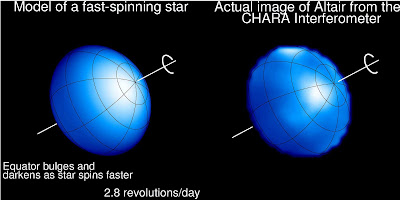- In Probing stars with optical and near-IR interferometry, Theo ten Brummelaar, Michelle Creech-Eakman, and John Monnier explain how "new high-resolution data and images, derived from the light gathered by separated telescopes, are revealing that stars are not always as they seem." Now, the combination of radio telescopes to synthesize huge telescope apertures and gain the corresponding angular resolution is a well-established technique.
But adding interferometrically the wave crests of visible light from a star collected in two separate telescopes is a more recent development. Performing some Fourier transforms results in images with an angular resolution of milli arcseconds - enough to see a human on the moon, or to resolve the size and shape of stars.
Altair in the constellation Aquila, about twice as big as the Sun and 18 light years away, is rotating rapidly so that it is flattened. The image on the right has been created using interferometry with light waves. Credit: Ming Zhao (University of Michigan), from Imaging the Surface of Altair, John D. Monnier et al, arXiv:0706.0867v2. - Ocean waves are generated by fluctuating wind pressure on the water surface. Due to the dispersion of the phase velocity (longer waves run faster) and a weak interaction between different waves transferring energy to longer waves, dominant waves are the bigger the stronger and longer the wind blows. Together with the effect of opposing ocean currents, very big waves can emerge. In Rogue waves, Chris Garrett and Johannes Gemmrich look at the "rich and challenging physics [...] behind the gigantic ocean waves that seem to appear without warning to damage ships or sweep people off rocky shores."

Rogue wave in the Bay of Biscay, France. Credit: NOAA Photo Library, via Wikipedia.
Thursday, June 4, 2009
This and That
Combining waves can make for quite spectacular effects. The June edition of Physics Today has two interesting articles available for free describing such situations:
Subscribe to:
Post Comments (Atom)
No comments:
Post a Comment